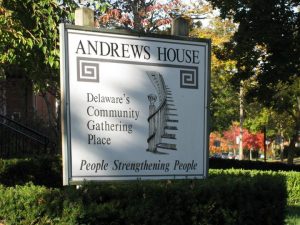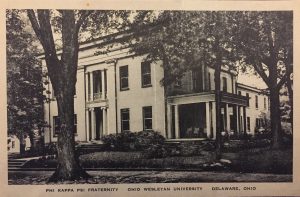
Hiram Griswold Andrews had no idea that his home would someday our town’s Andrews House. This Worthington, Ohio, native came to Delaware in 1831 and started a paper mill operation in Stratford. In 1844 he bought the lots at the southwest corner of Franklin and Winters streets from the Board of Education. There he built a Greek revival mansion with Ionic columns at the front and side entrances. This home is said to duplicate two other homes the Andrews family had inhabited, one in New England and the second just west of Pittsburgh. The Delaware house took close to two years to complete.
The Samuel Lynbrand family who operated the Delaware Chair Factory acquired the house in 1888. After Mrs. Isabella Lynbrand died in 1901, the role of the mansion at 39 W. Winter St. was destined to change dramatically. It would be transformed from a private residence to one of public significance–Delaware’s first hospital. That change came about through Jane Morris Case, a widow of a Columbus physician. As a visitor to Delaware, Mrs. Case noted that the town had no hospital and discussed the lack with her doctor, A.J. Willey. She stipulated in her will that she wanted her estate to be given to charitable causes. After her death, Dr. Willey approached the trustees of her estate with the question of the mansion becoming a hospital. In the summer of 1904 the property was purchased for $8,500 and deeded to five Delaware citizens who were to comprise the Board of Trustees of the Jane M. Case Hospital Association. The deed came with the provision that if the building ever ceased to be put to charitable use, it or the $8,500 would revert to the estate of Jane M. Case. The board’s main task was to keep the hospital nonsectarian and free of politics. A daunting estimate of $7,540 was projected in needed repairs, renovation, and equipment costs for the hospital.

Area churches and individuals provided the funds and the old building was remodeled with new plumbing, electrical wiring, and new floors of yellow pine. The larger rooms were divided to make smaller ones. An addition built onto the southeast end of the original building measured 41 feet long by 21 feet wide and provided a first-floor rear entrance leading to a new elevator an emergency room, a bathroom and two private rooms. On the second floor the addition contained an operation room, anesthetizing and instrument rooms, and a bathroom. The first floor of the original building now included a reception room, an office, pharmacy, three private rooms, two examining rooms, the men’s public ward, dining room, kitchen and pantries. The second floor had five private rooms, the women’s ward, the children’s ward, and the servants’ rooms in the rear wing. The elevator was accessible from both the old and new portions of the building, and a dumb waiter was installed beside the elevator to transport food from the kitchen to the second floor. The basement held the laundry and cellar store room. An open house held on July 26, 1906, celebrated the hospital’s official beginning. Three patients were admitted the next day and the first operation was scheduled two days following the grand opening. The hospital expanded from about 22 beds to 36 beds during its 20 years in this location, and then it was moved to where Grady Memorial Hospital stands today. The Jane M. Case Hospital Association kept the title to the property until 1930 when the building became the home of Ohio Wesleyan University’s Phi Kappa Psi fraternity.

Students renamed the hospitals servants’ quarters at the rear of the house “The Gulch” as it is still known today. The balcony above the Winter Street doorway became the home for the fraternity cannon. It was the cannon that caused major damage to the beautiful circular stairway. The Sigma Alpha Epsilon fraternity was the rival of the Phi Kappa Psi brotherhood. One night they entered the building and stole the cannon. On their way down the circular stairs, they dropped the cannon breaking several of the spindles of the banister as it fell. Even with all the racket, they were successful in their heist. In 1960 the University’s Tau Kappa Epsilon fraternity purchased 39 W. Winter Street, and it remained the fraternity’s residence until 1993.
St. Peter’s Episcopal Church, the building next door neighbor at 45 W. Winter Street, bought the house and with the help of other denominations and organizations in Delaware had worked to restore the worn and damaged house to a beautiful, functional building once again, the city of Delaware’s Andrews House. Even the sidewalk around the house along the Winter and Franklin Streets is paved with bricks now as it was in 1845. Andrews House embodies the themes of its previous 150-year history, providing hospitality, healing, education, and service. Andrews House fulfills its motto, “People Strengthening People.”